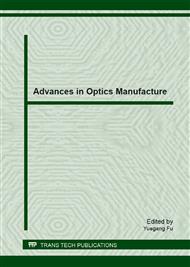p.97
p.103
p.111
p.115
p.124
p.131
p.137
p.142
p.147
Technical Analysis Method on Diffraction Grating Mechanical Scratching Based on Limited Elements and Cross Experiment
Abstract:
Quality of the groove shap made by original diffraction grating is the main factor to affect the diffraction efficiency .The process of diffraction grating scratch mainly depends on the experience of the operator. However, its shortage is time-consuming, difficult and waste. In order to overcome the issues mentioned above, the new method has been put forward in this paper: simulate the process of diffraction grating scratch by limited element analysis and cross experiment, find out the process factor that affects the quality of the groove by rang analysis and sort. This method provides the reference to the process design of mechanical scratch grating and instruction to the adjustment of the grating trial scratch .It has practical significance on improving the quality of mechanical grating.
Info:
Periodical:
Pages:
124-130
Citation:
Online since:
May 2013
Authors:
Keywords:
Price:
Сopyright:
© 2013 Trans Tech Publications Ltd. All Rights Reserved
Share:
Citation:


